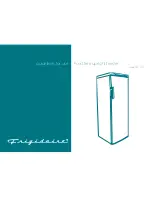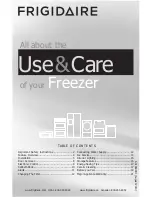
16
Mise en route
Vérifications avant mise en
route
– Vérifier que les vannes de refoulement et de
départ liquide sont ouvertes
– S’assurer de l’absence de toute fuite de fluide
frigorigène
– Ouvrir les vannes du circuit d’eau et s’assu-
rer que l’eau circule dans le refroidisseur
quand la pompe est en service.
– Purger l’air du circuit hydraulique
– Vérifier le fonctionnement du contrôleur de
circulation et l’asservissement eau glacée.
– Vérifier le serrage de toutes les connexions
électriques.
– S’assurer que la tension du réseau corres-
pond à la tension de l’appareil et que sa valeur
reste dans les limites admissibles (
+
0
6 %
–10 %
par
rapport aux tensions nominales).
– Laisser sous tension les résistances de car-
ter des compresseurs quelques heures avant
le fonctionnement du compresseur (6 heures).
Toucher les carters pour s’assurer que tous les
réchauffeurs ont fonctionné correctement (ils
doivent être tièdes).
– Vérifier le sens de rotation des ventilateurs
(LWN).
Faire fonctionner les émetteurs de froid pour
avoir une charge calorifique afin que les grou-
pes d’eau glacée puissent fonctionner.
Mettre en route. Suivre les instructions para-
graphe 12 du manuel PRS1.
Vérifier immédiatement
que les ventilateurs du condenseur tournent
dans le bon sens (LWN) (dans le cas contraire
intervertir 2 fils d’alimentation générale).
que le refoulement chauffe
que l’ampérage absorbé est normal
(voir tableau et valeur plaquée sur les com-
presseurs)
vérifier le fonctionnement de tous les appa-
reils de sécurité
(voir tableau pour valeur de réglage).
NOTA : Au début du fonctionnement d’un
groupe de production d’eau glacée, de nom-
breux ennuis sont dus à une pression d’aspira-
tion trop basse ou à une pression de conden-
sation trop haute.
Pression d'aspiration trop
basse
– présence d’air dans le circuit d’eau glacée
– pompe d’eau glacée trop faible, débit insuffi-
sant
– pompe d’eau glacée ne fonctionne pas nor-
malement (tourne dans le mauvais sens).
– température d’eau glacée trop basse, man-
que de charge calorifique.
Pression de condensation
trop élevée
– Débit d’eau de refroidissement insuffisant.
– Température d’eau de refroidissement trop
élevée.
– Mauvais fonctionnement de la tour ou de l’aé-
roréfrigérant.
– Condenseur encrassé ou entartré.
– Excès de charge en fluide frigorigène.
– ventilation incorrrecte (LWN) (obstacle à l’as-
piration ou au refoulement, ventilateurs tour-
nent dans le mauvais sens)
– air trop chaud à l’aspiration (LWN) (recy-
clage).
Starting the unit
Vérifications before star
tingup
– Verify that the discharge and liquid outlet
valves are open.
– Make certain that there are no refrigerant
leaks.
– Open the water circuit valves and make cer-
tain that water circulates in the chiller when the
pump is running.
– Vent air from the hydraulic circuit
– Verify functioning of the flow switch and
chilled water interlocking.
– Verify tightness of all electrical connections.
– Ensure that the mains voltage corresponds to
the unit voltage and that this value remains
within admissible limits (
+
0
6 %
–10 %
of nominal volt-
age).
– Make the compressors crankcase heaters
live several hours before putting the com-
pressors into operation (6 hours).
Touche the crankcases to make sure that the
heaters are working correctly (they should be
warm).
– Verify that the fans turn in the correct direc-
tion (LWN).
Make the terminal units running in order to get
a heating capacity to allow the chillers to run.
Commissioning : follow the instructions in the
section 12 of the PRS1.
Verify immediately
that the condenser fans turn in the correct
direction (LWN) (if not, reverse 2 supply wires).
that the discharge heats up
that the absorbed current is normal
(see table and rated value on the com-
pressors).
check that all the safety devices are worling
(see table for setting values).
NOTE : With initial functioning of water chillers,
numerous problems are due to a suction pres-
sure that is too low or a condensing pressure
that is too high.
Suction pressure too low
– presence of air in the chilled water circuit
– inadequate chilled water pump, insufficient
flow
– chilled water pump not funcitoning properly
(turning in the wrong direction)
– chilled water temperature too low, lack of
heating load.
Condensing pressure too
high
– Cooling water flow too low.
– Cooling water temperaturetoo high.
– Faulty operation of cooling tower or dry-
cooler.
– Scaled or fouled condenser.
– Excessive refrigerant fluid load.
– incorrect ventilation (LWN) (obstacle at the
intake or discharge, fans turning in ghe wrong
direction).
– intake air too warm (LWN) (recycling).
Inbetriebnahme
Überprüfungen vor der Inbetriebnahme
- Sicherstellen, daß die Ausblasventile und der Flüssig
keits-austritt geöffnet sind.
- Sicherstellen, daß kein Leck im Kältemittelkreis vor
handen ist.
- Die Ventile des Wasserkreises öffnen und prüfen, ob
das Wasser im Flüssigkeitskühler zirkuliert, wenn die
Pumpe eingeschaltet ist.
- Den Wasserkreis entlüften.
- Den Betrieb des Strömungswächters und die Kaltwas
serregelung überprüfen.
- Sicherstellen, daß alle elektrischen Anschlüsse fest
montiert sind.
- Überprüfen, ob die Netzspannung der Gerätespan
nung entspricht und der Spannungswert innerhalb der
zulässigen Grenzen bleibt (
+
0
6 %
–10 %
gegenüber der
Nennspannungen).
- Die Kurbelwannenheizung der Verdichter 6 Stunden
vor dem Einschalten der Verdichter unter Spannung set
zen.
Die Gehäuse anfassen, um zu prüfen, ob alle Erhitzer
ordnungsgemäß funktionieren (Gehäuse müssen lau
warm sein).
−
Die Drehrichtung der Ventilatoren
(LWN)
prüfen.
Die Kälteabnahme einschalten, um die für den Betrieb
des Flüssigkeitskühlers notwendige Wärme zu erhal
ten.
Zum Einschalten die Anweisungen in Kapitel 12 der
Bedienungsanleitung des PRS1 lesen.
Sofort nach dem Einschalten überprüfen
ob die Ventilatoren des Verflüssigers
(LWN)
in der
richtigen Richtung drehen (sonst die beiden Drähte der
Stromversorgung umstecken).
ob das Gebläse sich erwärmt
ob die Stromaufnahme normal ist (siehe Tabelle und
Werte auf dem Typenschild des Verdichters)
ob alle Sicherheitsvorrichtungen korrekt funktionieren
(siehe Tabelle für die Vorgabewerte)
HINWEIS
: Beim Anlaufen eines Kaltwassersatzes
können folgende Probleme aufgrund eines zu niedrigen
Ansaugdrucks oder eines zu hohen Verflüssigungs
drucks auftreten.
Ansaugdruck zu niedrig
- Luft im Kaltwasserkreis
- Kaltwasserpumpe zu schwach, unzureichende Was
sermenge
- Kaltwasserpumpe funktioniert nicht korrekt (läuft in
der falschen Richtung)
- Kaltwassertemperatur zu niedrig, Fehlen einer
Wärmeabnahme
Verflüssigungsdruck zu hoch
- Kühlwassermenge zu gering
- Kühlwassertemperatur zu hoch
- Betriebsstörung des Kühlturms oder Luftkühlers
- Verflüssiger verschmutzt oder verkalkt
- Zu hohe Kältemittellast
- Ventilatorstörung (LWN) (Ansaugung oder Ausbla
sung wird behindert, Ventilator dreht in der falschen
Richtung)
- Luft beim Ansaugen zu warm (LWN) (Luftrückführung)







































